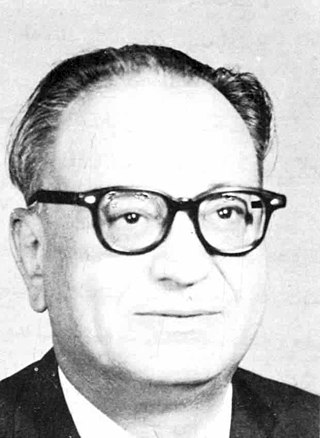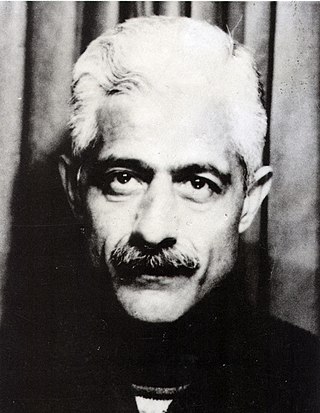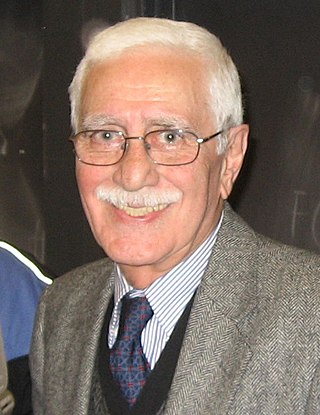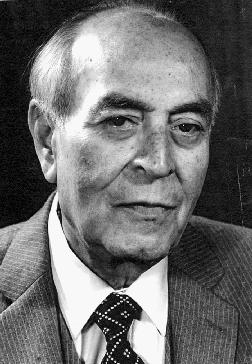
Dari, Dari Persian, or Eastern Persian is the variety of the Persian language spoken in Afghanistan. Dari Persian is the Afghan government's official term for the Persian language; it is known as Afghan Persian or Eastern Persian in many Western sources. The decision to rename the local variety of Persian in 1964 was more political than linguistic to support an Afghan state narrative. Dari Persian is most closely related to Tajiki Persian as spoken in Tajikistan and the two share many phonological and lexical similarities. Apart from a few basics of vocabulary, there is little difference between formal written Persian of Afghanistan and Iran; the languages are mutually intelligible. Dari Persian is the official language for approximately 35 million people in Afghanistan and it serves as the common language for inter-ethnic communication in the country.

Gholamhossein Mosahab was an Iranian mathematician and logician whose works have been praised by other scholars such as Iraj Afshar and Najaf Daryabandari. Being fluent in Persian, Arabic, French and English, he studied in Iran, France and England; and received his PhD from Cambridge University. He was the founder of Mosahab Institute of Mathematics, Teacher Training University and was the director of the Institute of Mathematics of Kharazmi University from 1972-1974.

Seyyed Jalāl Āl-e-Ahmad was a prominent Iranian novelist, short-story writer, translator, philosopher, socio-political critic, sociologist, as well as an anthropologist who was "one of the earliest and most prominent of contemporary Iranian ethnographers". He popularized the term gharbzadegi – variously translated in English as "westernstruck", "westoxification", and "Occidentosis" – producing a holistic ideological critique of the West "which combined strong themes of Frantz Fanon and Marx".

Sadegh Hedayat was an Iranian writer and translator. Best known for his novel The Blind Owl, he was one of the earliest Iranian writers to adopt literary modernism in their career.

Mehdi Akhavān-Sāles, or Akhavān-Sāless, pen name Mim. Omid was a prominent Iranian poet. He is one of the pioneers of Free Verse in the Persian language.

Samad Behrangi was an Iranian teacher, social activist and critic, folklorist, translator, and short story writer of Iranian Azerbaijani descent. He is famous for his children's books, particularly The Little Black Fish. Influenced by predominantly leftist ideologies that were common among the intelligentsia of his era, which made him popular among the Organization of Iranian People's Fedai Guerrillas, his books typically portrayed the lives of the children of the urban poor and encouraged the individual to change his/her circumstances by her own initiatives.

Alborz High School is a college-preparatory gifted high school located in the heart of Tehran, Iran. It is one of the first modern high schools in Asia and the Middle East, named after the Alborz mountain range, north of Tehran. Its place in the shaping of Iran's intellectual elite compares with that of Eton College in England and institutions such as Phillips Academy, Phillips Exeter Academy, and Milton Academy in the United States.

Prince Iraj Mirza, titled Jalāl-ol-Mamālek, was a prominent Iranian poet. He was the son of Prince Gholam-Hossein Mirza. Iraj Mirza was known for his modern poetry, which often critiqued traditional customs. In addition to his original works, he translated literary pieces from French into Persian.

Iraj Afshar was a bibliographer, historian, scholar, professor, and a figure in the field of Persian studies. Afshar was a professor emeritus of the University of Tehran. He was a consulting editor of Encyclopædia Iranica at Columbia University.

Iraj Bashiri is professor of history at the University of Minnesota, United States, and one of the leading scholars in the fields of Central Asian studies and Iranian Studies. Fluent in English, Persian, Tajik, and several Turkic languages, Bashiri has been able to study and translate works otherwise inaccessible to the mostly Russian-speaking Central Asian studies community. Bashiri’s career focus started on Iran, and engaged also with Central Asia, notably the Tajik identity and the relations between Tajiks and the Turkic people of Central Asia, namely the Uzbeks.

Iraj Pezeshkzad was an Iranian writer and author of the famous Persian novel Dā'i Jān Napoleon published in the early 1970s.
Iraj Kalantari Taleghani was an Iranian architect, noted for his contribution to the modernization of Iranian architecture.

Iraj Eskandari was an Iranian communist politician. A Qajar prince, Eskandari received French education. He was the first general secretary of the Tudeh Party of Iran and a member of parliament. In the summer of 1946 he was named a Minister of Commerce and Industry in Qavam's coalition cabinet.

Mohammad Taqi Danesh Pajouh or Mohammad Taghi Daneshpajouh was a writer, musician, translator, orientalist and Iranian scholar, a member of the Academy of Persian Language and Literature, professor at the University of Tehran and the father codicology of Iran.

Iraj Rahmanpour born in 1957 is an Iranian singer, songwriter, and writer، who also has written and musical works about the culture and art of the Zagros region and the music of Lori andaLeki.
Iraj Tanzifi was an Iranian scholar and sculptor.

Iraj Safdari was an Iranian Make-up Artist and Actor. He has three children.

Iraj Gorgin was an Iranian-American radio and television broadcaster and journalist.

Ahmad Eghtedari was an Iranian teacher, lawyer, writer, historian and geographer who was regarded as a prominent scholar in Persian Gulf studies. Historically, he was a descendant of Gerashi thanes. In his youth, he traveled on foot along the coasts of the Persian Gulf and Oman Sea and began mapping and documenting their topography.
















